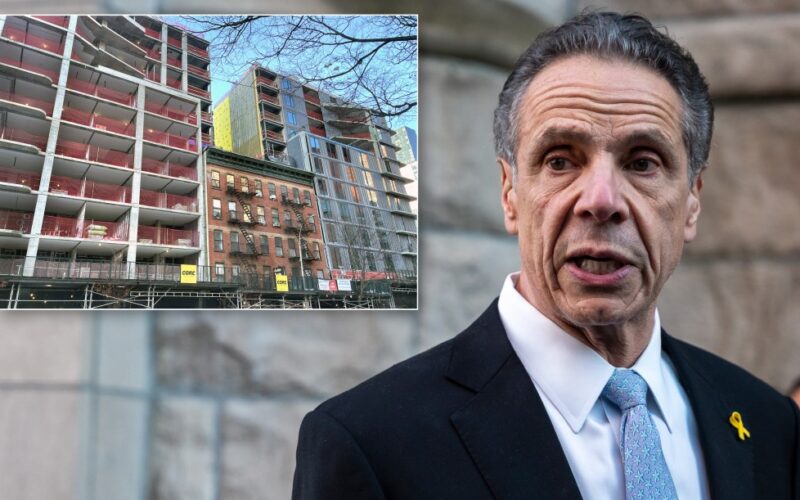Mayoral candidate Andrew Cuomo is rolling out a housing plan that seeks to build 500,000 new apartments in New York City over 10 years, but the blueprint is light on some key specifics and contains few novel policy prescriptions for how to achieve the ambitious goal.
The plan, which was exclusively shared with the Daily News ahead of its Sunday release, touts Cuomo’s years of relevant experience, first as secretary of the U.S. Department of Housing and Urban Development in the late 1990s and then as governor between 2011 and 2021. The 29-page proposal is presented as a roadmap for how to turn the tide on the city’s housing crisis, which has caused rents to skyrocket amid a dearth of vacant apartments and surging demand.
The plan from Cuomo, who’s polling as the frontrunner to win this June’s Democratic mayoral primary, says “most” of the half million apartments he envisions constructing by 2035 would be “affordable for the majority of people who live here now or would relocate here but can’t afford the cost.”
David Dee Delgado/Getty Images
Andrew Cuomo. (Photo by David Dee Delgado/Getty Images)
The plan doesn’t specify exactly how many of the 500,000 units would be affordable, or provide detailed breakdowns on affordability parameters that a Cuomo administration would require for private developers to build the apartments in question.
A Cuomo campaign official said the goal is for two thirds of the proposed 500,000 units to be affordable. The official told The News the ex-governor can’t make a commitment to that effect, though, due to complicating factors, such as construction costs and how they’ll be impacted by President Trump’s aggressive tariff policies.
The plan says an apartment is generally considered affordable if the rent doesn’t exceed 30% of the income of a household earning 60% of the neighborhood’s median — a calculus some advocates have said produces units that are too expensive for too many residents.
Mayor Adams, who dropped out of the Democratic primary this month to instead seek reelection as an independent in November, also vowed in 2022 to produce 500,000 new units over 10 years, a benchmark experts say his administration is behind on.
Cuomo’s primary opponents have made big promises, too, like Brooklyn state Sen. Zellnor Myrie, who vows to as mayor build or preserve 1 million apartments in 10 years, and Queens Assemblyman Zohran Mamdani, whose housing plan centers on freezing rent for stabilized tenants and building 200,000 new stabilized units.
Cuomo’s campaign declined to make him available for an interview with The News about his plan. But Cuomo said in a written statement that it “meets the scale of the crisis.”
“If working people can’t afford to live here, then this won’t be New York anymore. We must stop talking and effectively address our housing crisis or we risk losing the soul of New York City,” said Cuomo, who resigned as governor in 2021 amid sexual misconduct accusations he denies. “We must build, preserve, and protect — at a pace and scale we’ve never done before.”
In pushing for a housing production boost, Cuomo’s plan largely relies on existing programs, like the 485-x tax incentive for developers, as opposed to new proposals, arguing the levers at New York’s disposal are potent, but need to be used in a better way. There are some new initiatives, such as a proposal to exempt faith-based institutions from having to go through lengthy zoning processes if they want to add housing on their properties, a suggestion the plan says could produce tens of thousands of new affordable apartments.
One area where Cuomo distinguishes himself from other mayoral candidates is his plan’s commitment to oppose — at least for now — most zoning changes that’d allow for the construction of taller buildings with more apartments in “low-density neighborhoods.” The issue has become a political hot potato amid Adams’ “City of Yes” citywide rezoning plan, which proposes to build “a little more housing in every neighborhood,” including suburban outer-borough areas, where opposition to such development is strong.
When it comes to funding, Cuomo’s plan cites experts as saying an “increase of nearly $1 billion” per year in affordable housing subsidies over current levels would be necessary to achieve 500,000 new units in a decade.
The Cuomo campaign official said the ex-governor would actually like to see an increase of at least $1 billion. The campaign did not, however, identify funding streams for such an increase other than to say the bill should be footed by both the city and the state.

Robert Nickelsberg/Getty Images
Laborers work on a residential construction site in Brooklyn in January. (Robert Nickelsberg/Getty Images)
Housing production subsidies often come in the form of tax breaks for developers who commit to making a certain number of new units affordable, and Cuomo’s plan leans heavily on 485-x, which Gov. Hochul signed into law in 2022 to replace the expiring 421-a program.
The plan says Cuomo’s administration would work to ensure 485-x “sufficiently incentivizes new development” and then warns the program is at risk of creating “substantially less housing development” than its predecessor as it’s less “economically attractive” than 421-a because of “deeper affordability requirements.”
To that end, the plan says Cuomo would as mayor potentially seek to “reconvene stakeholders to identify changes” to 485-x “that can protect stakeholder interests,” indicating he’s open to peeling back some of the program’s affordability protections.
Cuomo, whose mayoral election efforts have drawn hundreds of thousands of dollars in donations from real estate developers, also wrote in the plan he’s supportive of “City of Yes,” which stands to create about 82,000 new units over 15 years, calling it “an important step.”
The plan says “further rezoning” is needed to get to the 500,000 benchmark. But it doesn’t pinpoint any new areas ripe for rezonings, only stating that “identifying additional commercial and manufacturing suitable for residential zoning is an important element of Andrew Cuomo’s Housing agenda.”








